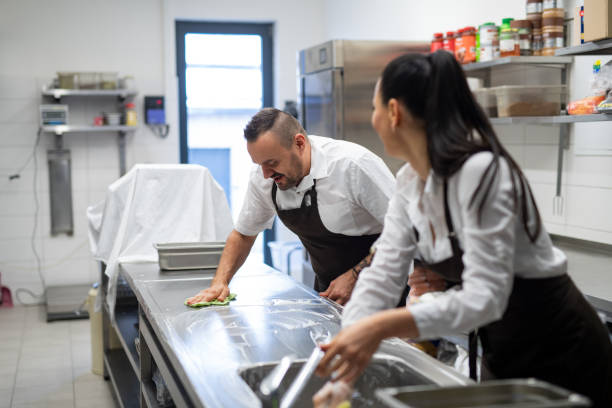In the bustling world of food service, maintaining a clean and hygienic kitchen isn’t just a matter of aesthetics—it’s a fundamental pillar of ensuring the safety of both your customers and your staff. Commercial kitchen cleaning goes beyond just tidying up; it involves meticulous attention to detail, adherence to regulations, and a commitment to best practices. In this guide, we’ll delve into the importance of keeping commercial kitchens clean and outline essential tips for ensuring safety and hygiene.
The Importance of Cleanliness in Commercial Kitchens
- Preventing Foodborne Illnesses: Bacteria, viruses, and other pathogens thrive in dirty environments. Failure to properly clean and sanitize surfaces can lead to the spread of foodborne illnesses such as Salmonella, E. coli, and Norovirus, putting your customers at risk and damaging your reputation.
- Ensuring Compliance with Regulations: Health and safety regulations set forth by local authorities mandate strict cleanliness standards for commercial kitchens. Failure to comply with these regulations can result in fines, closure orders, and even legal action.
- Preserving Food Quality: A clean kitchen is essential for maintaining the quality and freshness of food. Cross-contamination from dirty surfaces can compromise the taste, texture, and safety of ingredients, leading to spoilage and waste.
- Creating a Positive Image: Cleanliness is a reflection of your professionalism and commitment to excellence. A well-maintained kitchen not only instills confidence in your customers but also enhances the overall dining experience.
Essential Tips for Commercial Kitchen Cleaning
- Develop a Cleaning Schedule: Establish a comprehensive cleaning schedule that outlines daily, weekly, and monthly tasks. Assign specific responsibilities to staff members and ensure accountability for completion.
- Use the Right Cleaning Products: Select cleaning products and disinfectants that are approved for use in commercial kitchens and effective against a broad spectrum of pathogens. Follow manufacturers’ instructions for dilution, application, and contact time.
- Focus on High-Touch Surfaces: Pay special attention to high-touch surfaces such as countertops, cutting boards, utensils, and equipment handles. These areas are prone to contamination and require frequent cleaning and sanitization throughout the day.
- Practice Proper Food Handling: Incorporate good food handling practices into your cleaning routine to prevent cross-contamination. Store raw and cooked foods separately, use color-coded cutting boards and utensils, and sanitize equipment between uses.
- Maintain Ventilation Systems: Clean and inspect ventilation hoods, ducts, and filters regularly to prevent the buildup of grease and other contaminants. Proper ventilation is crucial for maintaining air quality and reducing fire hazards in the kitchen.
- Train Your Staff: Provide comprehensive training to your staff on proper cleaning techniques, sanitation protocols, and food safety regulations. Empower them to take ownership of cleanliness and emphasize the importance of their role in maintaining a safe and hygienic environment.
- Conduct Regular Inspections: Schedule regular inspections of your kitchen to assess cleanliness standards, identify areas for improvement, and address any issues promptly. Keep detailed records of inspections and corrective actions taken to demonstrate compliance with regulations.
Ensuring Safety and Hygiene
Cleanliness is non-negotiable. By prioritizing cleanliness and hygiene, you not only safeguard the health and safety of your customers and staff but also uphold your reputation as a reliable and professional establishment. Incorporate the essential tips outlined in this guide into your cleaning routine, and make cleanliness a cornerstone of your operation. Your customers will thank you, and your business will thrive as a result.



